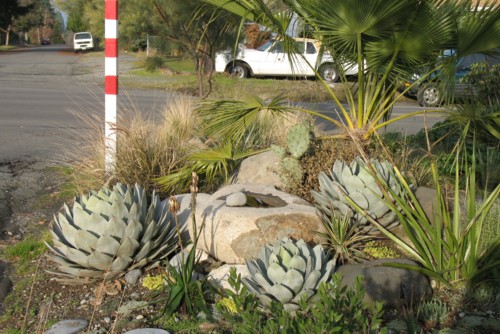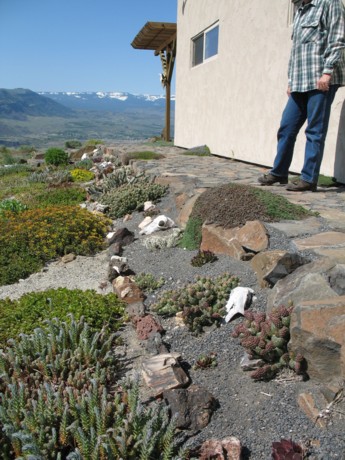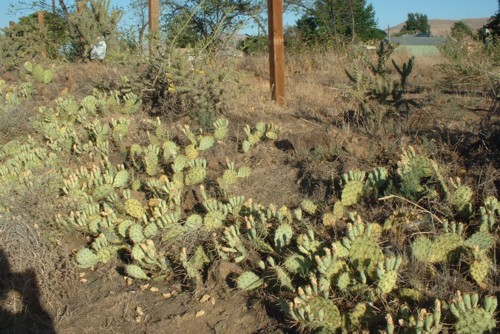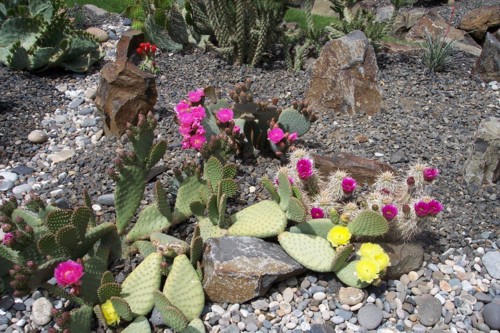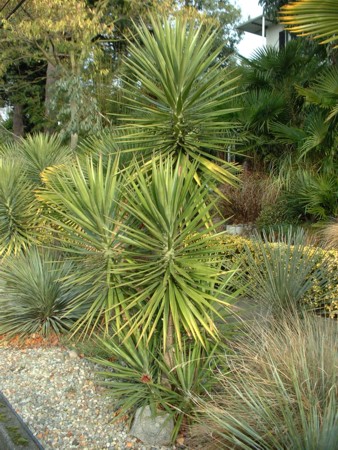The Nitty Gritty of Desert Garden Design
So, you want to grow cold hardy cacti and succulents outdoors! Now the question is: how to get started on the right foot? Here is a basic guide to help you achieve a successful desert garden. What follows is not really a step-by-step process; rather, it is a list of considerations (in no particular order) to be made all together before you get started, and to keep in mind through the early stages of the development of your garden. I'll focus on applicability for Pacific Northwest gardeners, though many of the principles discussed here can be applied much more broadly. Each situation is different. Every gardener will have a different space, aspect and microclimate to work with, as well as differing goals. You may be interested only in cacti, or in certain kinds of cacti. Or you may want to have a collection of just Agaves. You may want your desert garden to be versatile enough to include a lot of non-succulent plants. So the first step in this process is to evaluate what your goals are and what is possible. Not surprisingly, west of the Cascades most desert plants prefer a sunny aspect with good summer heat accumulation and outstanding soil drainage. Sheltered gardens are preferred over frost pockets, but gardeners in frost pockets still have many choices if all other conditions are ideal. If your garden is exceptionally rainy, cool in summer, frosty in winter, foggy, or windy, different things will and will not be possible, and certain plants will have to be ruled out. West of the Cascades, desert garden selections need be hardy only to 0 - 15°F, but gardeners must keep excessive rainfall in mind. Gardeners east of the Cascade Crest can get away with more moisture-sensitive species but must choose only very cold-hardy selections. If your garden is predominantly shady, only a very few desert plants will survive, but if you can find an area that receives at least 5 or 6 hours of sun daily (in summer), many more things become possible. Desert gardens can be planted on a sunny bank on the south or west side of a house facing away from it, or on the north side (set back a ways) facing your residence so that you can enjoy the view. They are also an excellent fit for sidewalk planting strips in urban areas, where reflected heat from pavement is plenteous and heavy watering is less convenient than closer to the house.
Design the garden so that common themes are repeated: for example, plants of similar shape can be duplicated in a variety of sizes and colors using various carefully selected species from the same genus. Perhaps the reason desert gardens leave such an impression is that cacti and succulents lend themselves to this technique very readily. Possible plant combinations include Yucca elata with Y. nana, Opuntia engelmannii with O. macrorhiza, Agave protamericana together with A. toumeyana and A. gracilipes, or Denmoza rhodacantha together with some of the smaller Echinopsis and Pediocactus. Other suggestions follow the basic rules of effective garden design. Raise the beds and sink the paths for better viewing. Set larger and trunk-forming plants as centerpieces or in the back of the bed, with smaller plants toward the front. Make use of texture and color contrast as much as possible. The most effective desert gardens incorporate rock (although I have seen it done with surprisingly little). Schools of thought regarding the use of rock in gardens vary widely, but I am generally of the opinion that the more (and larger) rocks you can tactfully place in a cactus garden, the better. Of course, you will want to finish all the rockwork before you plant anything. The type of rock selected should depend on your budget and what is available to you. Rocks are more effective if set rather deeply and made to appear as natural as possible, and should be used especially liberally around the border of the garden to clearly delineate the desert garden from adjacent areas. A mulch of gravel (discussed below in greater detail) is also commonly used. Most people think that the gravel should be composed of the same material as your larger rocks to look as natural as possible. However, I think a successful garden can be made with something of a two-tone look - for example, you could use dark basaltic rock with pea gravel, or large rounded river rock with red lava rock for gravel.
As you are selecting plants, consider carefully the water needs of each. The majority of cacti, succulents and desert plants actually prefer some water - even lots of water, in some cases. The problem is that in the Pacific Northwest, it all falls out of the sky at the wrong time of the year. Many popular cacti and succulents native to the US Southwest and Mexico (especially in mountainous areas), as well as much of Bolivia and Argentina, experience a significant amount of rainfall in the summer, without which many of them would languish in the heat. This should be considered if you want to grow California natives requiring a summer dry period (manzanita, for example) alongside summer-moisture-loving cacti and succulents from the mountains of Arizona or Mexico. Larger desert gardens can be subdivided into zones based on the plants' irrigation and soil preferences. In a smaller garden, a choice will have to be made as to how much water it will receive, and certain plants may survive but not grow as quickly or as well without enough water - that, or else plants requiring a summer dry period have to be substituted with look-alikes that don't (for example, a California manzanita could be substituted with Arizona's A. pringlei or A. pungens). If you have not started yet and need to make this choice, or already have an irrigation system you plan on incorporating with your desert garden, be aware that a wider variety of desert plants can be grown with some summer water than without. Should you opt to provide water, this need only be done for a few months starting sometime in late spring or early summer when the soil starts drying up, and can continue through mid or late August. Allowing the plants to go a little drier at the tail end of summer and early fall can help them harden off a bit before winter. Watering frequency depends on your soil and local climate. In the hot deserts of Eastern Washington, many cacti and Agaves from the summer-wet Arizona mountains will appreciate being watered several times a week in hot weather. West of the Cascades, once a week in summer seems about right if you have heavy or moisture retentive soil below your well-drained bed, or twice a week if you have very sharp drainage. With too little water, desert plants will usually survive but may look desiccated and put on little new growth. (Again, plants native to summer dry areas are another matter - these rules certainly don't apply to Pacific Northwest or California natives.) Watering can be accomplished with a sprinkler or conventional residential irrigation system. However, I can think of no better use for those soaker hoses that are made from old rubber tires than watering cacti. They can be placed before the gravel mulch is applied and the cacti and succulents can enjoy a long drink inconspicuously. Also, soaker hoses conserve water compared to sprinklers since little or nothing is lost to evaporation - part of the reason for making use of desert plants to begin with.
When it comes time to plant your plants, a couple tips should be kept in mind. First of all, it's advantageous to plant in the spring so that the plants have the longest possible period of time to get established before the winter frosts come. It's also preferable to start with the largest plants possible - this is especially true of some Agaves and Yuccas which are MUCH hardier at maturity than as seedlings. For most medium to large Agaves, I recommend starting with a two-gallon plant. Beware of really big (usually field-dug) plants with undeveloped or heavily pruned root systems - despite the immediate visual impact they provide, they will take many years to become well established and in the meantime will be much more vulnerable to freezing than container-grown plants with well grown root systems. A general rule is to plant plants at the same soil level they were in the pot. But if you are using a thick mulch of large gravel, some plants can be sunk just a little deeper than the mulch surface so the rootball doesn't protrude. The bottom of the rootball should come into contact with something the roots can grow into - for example, a well-drained compost/gravel blend - not just rock. If your potted plant has been grown in very heavy or moisture retentive soil, it may be necessary to remove most of this and bare-root the plant before planting it out.
Weeding a desert garden can be problematic for those of us who don't like to get our fingers full of spines. The best way to approach this is good old fashioned preventative maintenance. Don't place the garden adjacent to an unmaintained field where a lot of weed seeds are likely to blow into it, or near any plants that self-sow or spread at the roots such as bamboos or weedy invasive grasses. When you find a weed, always pull it as soon as you see it - don't wait because before you know it, it will go to seed and all will be lost! With a clean gravel mulch and no source of weed seeds to invade the garden, you shouldn't have many problems for a long time. A carefully planned desert garden is one of the most rewarding and visually interesting projects one can accomplish. It also requires very little long-term maintenance, if done correctly in the first place. Now it's time to sit back and relax (with a glass of tequila?) and watch the cacti grow and flower, and let the Agaves and Yuccas do their spiny thing! |

